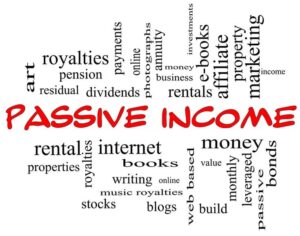A Beginner’s Guide to Passive Income Investments: Where to Start

Passive income investments are an excellent way to generate additional income without having to put in a lot of effort. In this article, I’ll provide a beginner’s guide to passive income investments, including what passive income is, why it’s important, the types of passive income investments available, how to evaluate them, and tips for managing them.
Understanding Passive Income and Why It’s Important
Passive income is income that you earn without actively being involved. This income can come from a variety of sources, including investments, real estate, or business ventures. The key difference between passive income and active income is that active income requires you to put in time and effort to earn it, whereas passive income requires less effort and can be earned even while you sleep.
Passive income is important because it can provide financial security and independence. It allows you to earn money without having to work more hours or take on additional clients. Passive income can also help you achieve your financial goals more quickly, such as saving for retirement or paying off debt.
Types of Passive Income Investments
There are many types of passive income investments available, including:
Dividend Stocks
Dividend stocks are shares of a company that pay out a portion of the company’s profits to shareholders. These payouts are typically made on a regular basis, such as quarterly or annually. Dividend stocks can be a great way to generate passive income, as they don’t require a lot of effort to maintain.
Rental Properties
Rental properties can be a great way to generate passive income, as they provide a steady stream of rental income each month. However, owning a rental property also requires a lot of work, such as finding tenants, managing repairs, and dealing with legal issues.
Peer-to-Peer Lending
Peer-to-peer lending is a form of investing where you lend money to individuals or businesses through an online platform. You earn interest on the loan, which provides a passive income stream. However, there is some risk involved with peer-to-peer lending, as borrowers may default on their loans.
Real Estate Investment Trusts (REITs)
REITs are companies that own and manage real estate properties. Investors can buy shares in the REIT, which provides a passive income stream through rental income and property appreciation. REITs can be a great way to invest in real estate without having to deal with the day-to-day management of properties.
How to Evaluate Potential Passive Income Streams
When evaluating potential passive income streams, it’s important to consider several factors, including:
Return on Investment
The return on investment (ROI) is the amount of money you can expect to earn from your investment. It’s important to consider the ROI when evaluating potential passive income streams, as it will determine how much money you can earn over time.
Risk
All investments come with some level of risk, and it’s important to understand the risks associated with each investment before committing your money. High-risk investments may offer higher returns, but they also come with a greater chance of losing your money.
Time and Effort Required
Some passive income investments require more time and effort than others. For example, owning a rental property requires a lot of work, whereas investing in dividend stocks requires very little effort.
Top Passive Income Ideas for 2023
Here are some of the top passive income ideas for 2023:
Dividend Stocks
Dividend stocks can be a great way to generate passive income, especially if you invest in companies with a long history of paying dividends.
Rental Properties
Rental properties can provide a steady stream of rental income each month, and with the increase in remote work, there may be more opportunities to invest in properties outside of your local area.
Digital Products
Creating digital products, such as ebooks or online courses, can generate passive income once the initial work is done. You can sell these products through your own website or through platforms like Amazon.
Affiliate Marketing
Affiliate marketing involves promoting someone else’s product and earning a commission on each sale. This can be a great way to generate passive income if you have a website or social media following.
Factors to Consider Before Choosing a Passive Income Investment
Before choosing a passive income investment, it’s important to consider several factors, including:
Your Risk Tolerance
Your risk tolerance will determine the types of investments you feel comfortable with. If you’re risk-averse, you may prefer investments with lower returns but also lower risk.
Your Investment Goals
Your investment goals will determine the types of investments that are most suitable for you. For example, if you’re saving for retirement, you may want to focus on investments with a long-term horizon.
Your Available Capital
Your available capital will determine the types of investments that are within your reach. Some investments, such as rental properties, require a large amount of capital upfront.
Tips for Successfully Managing Passive Income Investments
Managing passive income investments requires a different approach than managing active income. Here are some tips for successfully managing passive income investments:
Diversify Your Investments
Diversifying your investments can help reduce risk and increase your overall returns. Consider investing in a mix of stocks, bonds, real estate, and other assets.
Reinvest Your Earnings
Reinvesting your earnings can help you grow your passive income stream over time. Consider reinvesting dividends or rental income back into your investments.
Keep an Eye on Your Investments
While passive income investments require less effort than active income, it’s still important to keep an eye on your investments and make adjustments as needed. Regularly review your portfolio and make changes as necessary.
Risks Associated with Passive Income Investments
Passive income investments come with some risks, including:
Market Risk
All investments come with some level of market risk, which is the risk that the value of your investment will decrease due to market conditions.
Credit Risk
Some passive income investments, such as peer-to-peer lending, come with credit risk, which is the risk that borrowers will default on their loans.
Liquidity Risk
Some investments, such as real estate, can be difficult to sell quickly, which can make it difficult to access your money when you need it.
Common Misconceptions About Passive Income
There are several common misconceptions about passive income, including:
Passive Income is Easy
While passive income may require less effort than active income, it still requires work to set up and manage your investments.
Passive Income is Always Guaranteed
All investments come with some level of risk, and there is no guarantee that your passive income investments will generate the returns you expect.
Passive Income is Only for the Wealthy
Passive income investments are available to anyone, regardless of their income level. There are many low-cost investment options available, such as dividend stocks and index funds.
Resources for Learning More About Passive Income Investments
There are many resources available for learning more about passive income investments, including:
Books
There are many books available on the topic of passive income, including “The 4-Hour Work Week” by Timothy Ferriss and “Rich Dad Poor Dad” by Robert Kiyosaki.
Websites
There are many websites dedicated to passive income, including Investopedia and The Balance.
Financial Advisors
A financial advisor can help you evaluate potential passive income investments and create a plan that is tailored to your needs and goals.
Conclusion: Taking the First Steps Towards Creating a Passive Income Stream
Passive income investments can provide financial security and independence, but they require careful planning and management. By understanding the types of passive income investments available, evaluating potential investments, and managing them effectively, you can create a passive income stream that can help you achieve your financial goals. Start by considering your investment goals, risk tolerance, and available capital, and work with a financial advisor to create a plan that is right for you.



